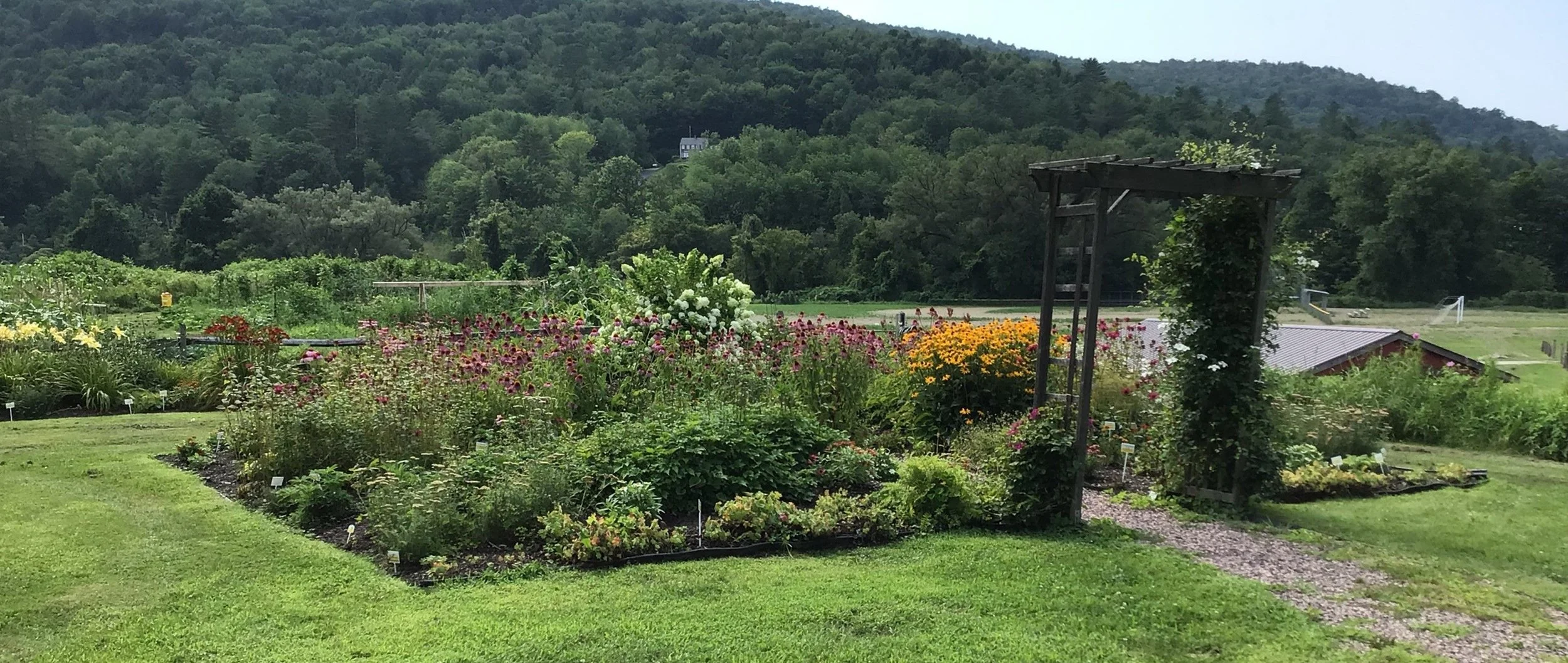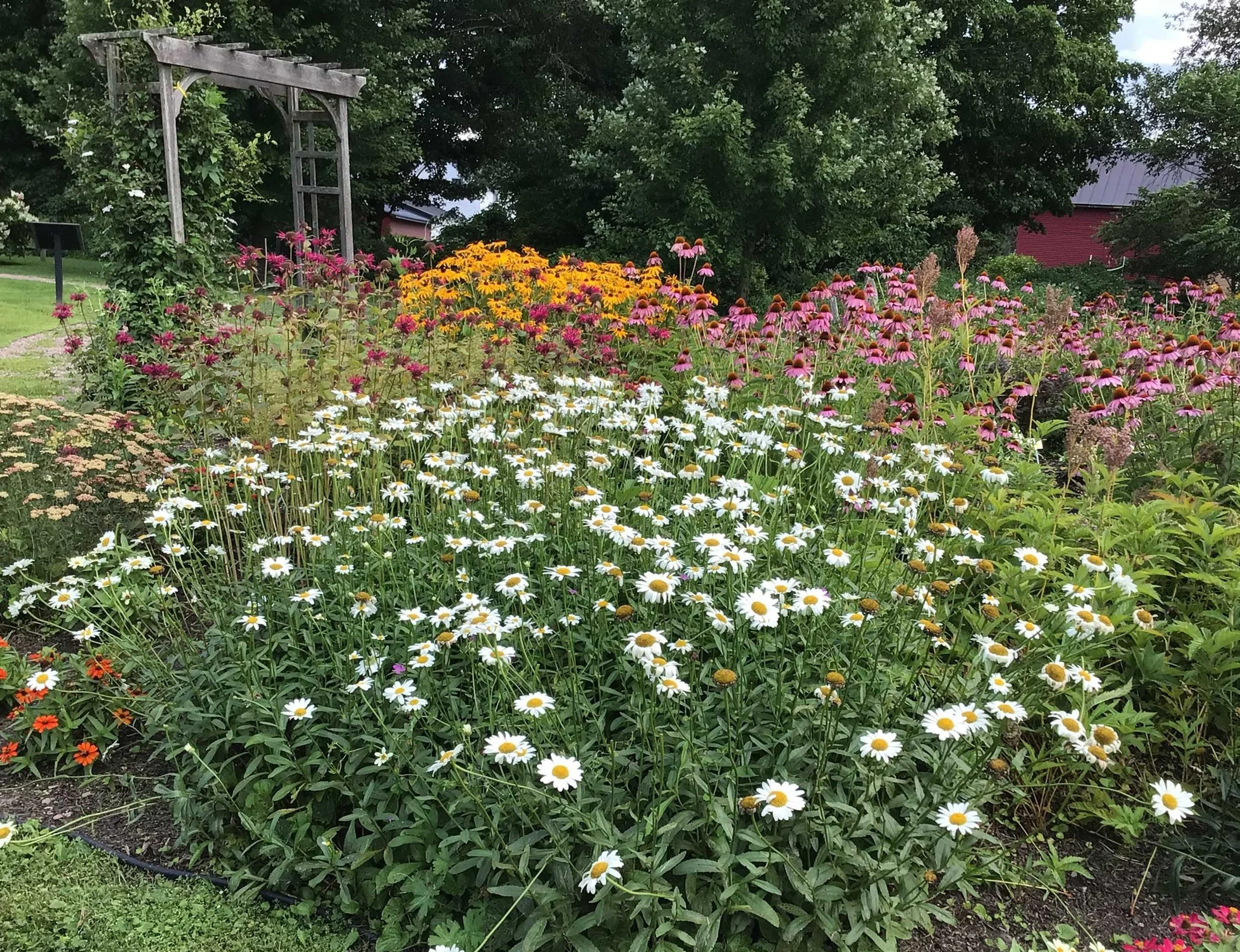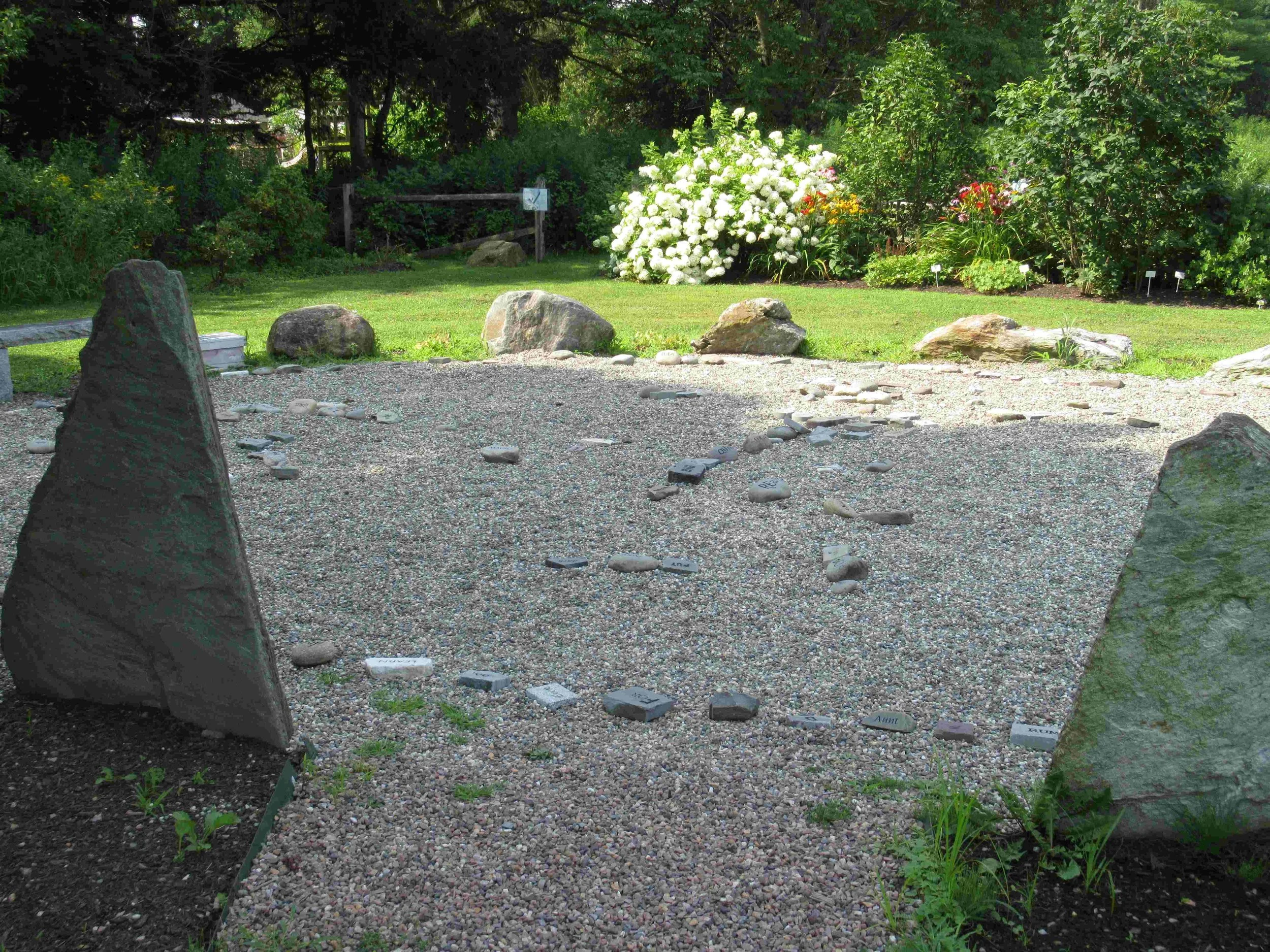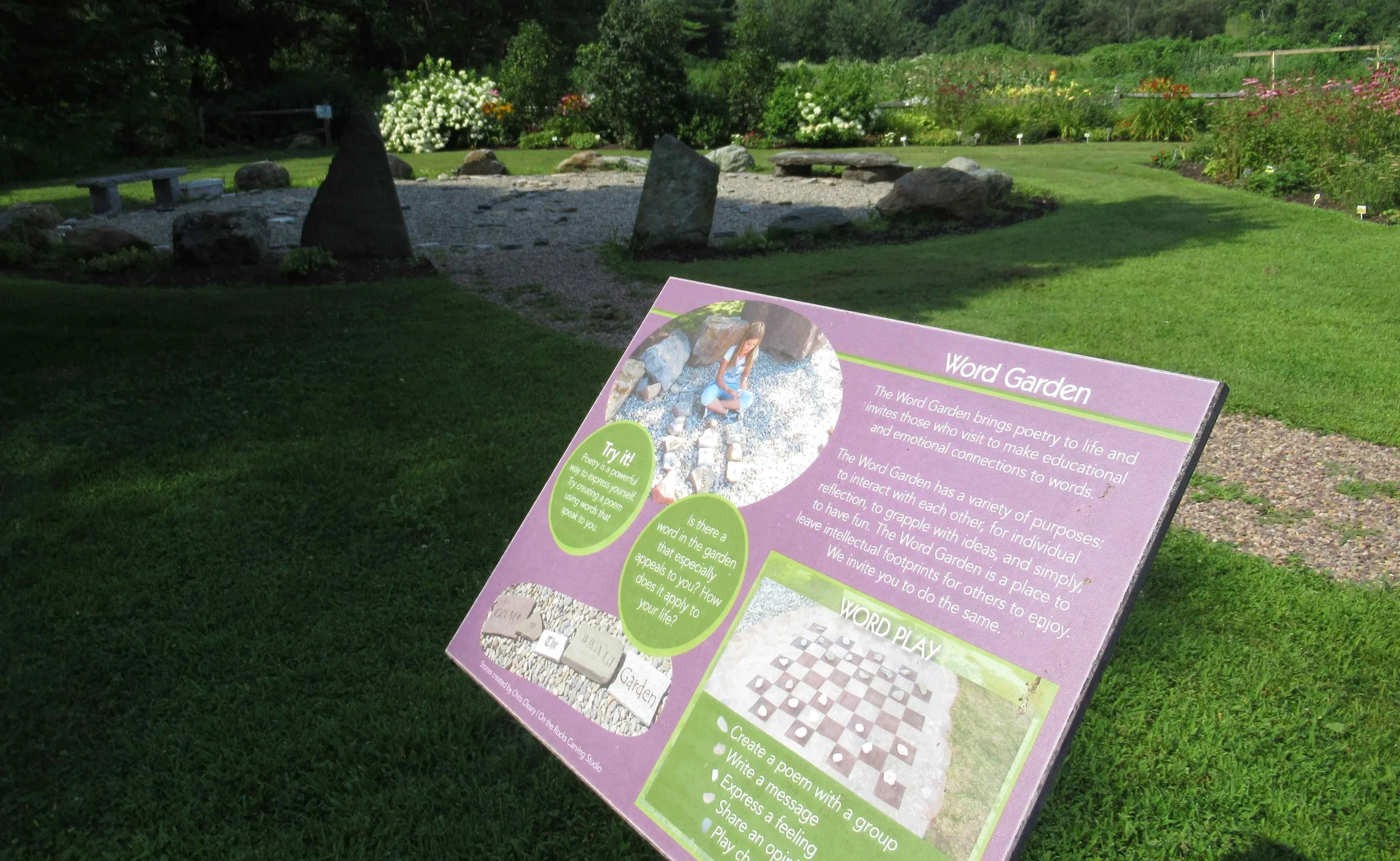Pssst…. What’s in a library’s garden? Hint: Things that grow + things to read
August 17, 2024 | By Judi Byron The library gardens are situated atop the bluff overlooking Dac Rowe Park, the Winooski River and Duxbury. Photo by Mary Miller
Libraries are patronized for their book selection, but did you know that there is more reading to be done outdoors in the Waterbury Public Library’s gardens?
Two special gardens – the Books in Bloom Garden and the Word Garden were conceived as ways to expand the library’s literacy beyond its walls, especially for children. The construction of the new library facility in 2016 was a perfect opportunity to create these special gardens.
Today, these established gardens and more are in full summer bloom and offer outdoor spaces for learning and activities.
Books in Bloom
Plants are labeled with their names and corresponding book titles in the Books in Bloom Garden. Photo by Mary Miller
Signs explain the gardens and offer questions to consider when exploring. Photo by Mary Miller
Photo by Mary Miller
The Books in Bloom Garden is shaped like an open book and invites readers of all ages to make connections between flowers and books representing each letter of the alphabet and all colors of the rainbow.
Each plant has a connection to a particular book alphabetically that play critical or whimsical roles in children’s literature by authors such as Rudyard Kipling and Beatrix Potter. For example, the letter “B” is represented by a blueberry bush and “Blueberries for Sal,” a classic beloved children’s book by Robert McCloskey that has won the hearts generations over since its first publication in 1948.
To accompany a visit to the garden and make it educational, the library has activity pages. Ask at the front desk for the A-Z laminated pages to use as a guide while exploring the garden.
The Word Garden
Rocks bearing words are scattered about in the Word Garden. Photo by Judi Byron
Next to the Book Garden is the Word Garden. Former educator and Library Commissioner Harriet Grenier was the champion behind this special garden. She traveled to Saint Michael’s College where she met with biology Professor Mark Lubkowitz and Valerie Bang-Jensen, an associate professor of education, creators of the “Books in Bloom” concept which features plants from favorite storybooks. They are co-authors of the book “Books in Bloom: Discovering the Plant Biology in Children’s Literature” that delves into these connections.
Photo by Judi Byron
The idea for the library’s Word Garden also came from these two professors and authors whose collaboration impressed Grenier. This special garden is a spot for poets and philosophers to put together ideas using stones with various words printed on them. Visitors to the garden can create poetry or an inspirational message using the movable words. The stones for the Word Garden were donated by Louise Reed and its bench is dedicated to Paul Reed, former president of Revitalizing Waterbury.
Detail in the Word Garden. Photo by Judi Byron
Along the west side of this circular gravel garden sits a stone bench with a checkers board. Ask inside the library for the game pieces in order to play.
At the back of the Word Garden is a new feature added recently, a StoryWalk inspired by Anne Ferguson at the Kellogg-Hubbard Library in Montpelier. The idea is to display a children’s picture book page-by-page along a path for children and adults to walk and read along together.
The library recently installed a StoryWalk using the book “Thunder Underground” by children’s poet Jane Yolen. In this collection of poems, Yolen takes readers on an expedition from the earth’s surface to deep underground. The poems cover animal burrows and human creations like subways, moving deeper to ancient cities and fossils, caves, magma, and Earth's tectonic plates. Find the StoryWalk at the Word Garden’s back fence.
A page with poems along the StoryWalk. Photo by Judi Byron
An ongoing collaboration
Truly a community endeavor, the Library Commission over the years has supported the garden projects with the help of community gardening volunteers enthusiastically maintaining them. A fence separates these gardens from the municipal Community Gardens where local residents rent plots each summer to grow vegetables and flowers for their own use.
The Friends of the Library support the Books in Bloom Garden and the Word Garden with funds to purchase the annuals to fill out the garden with color each summer, as well as the Town of Waterbury and Vermont Gardenscapes founder Mike LoSchiavo who supplies mulch. A River Runs Through It Garden Club purchased the picnic tables and the books to coordinate with the plants and flowers.
The Children’s Garden
Flowers and veggies fill the Children's Garden. Photo by Judi Byron
Flowers and mudpies go hand-in-tiny-hand in the Children's Garden. Photo by Sandra Schweikert
On the west side of the Community Gardens, the Waterbury Tree Board planted fruit trees in 2023 and near those now is the Children’s Garden, a new garden established in April conceived by Youth Services Librarian Sandra Schweikert. Evergreen Gardens provided soil and Welch Lumber & Custom Sawing supplied materials to build raised beds. Volunteers helped install the beds, spread wood chips and planted donated seeds and plant starts. Waterbury Public Works Director Bill Woodruff built the children’s wooden stools for the garden, too.
With the help of the Waterbury Recreation Department, Schweikert has been meeting weekly each Tuesday this summer with children and families to plant, weed, water, and harvest basil, tomatoes, beans and more in the new garden. There’s also mud to play in and bugs to catch and examine.
Tomatoes on the vine and basil nearby in the Children's Garden. Photo by Judi Byron
UVM Master Gardener, consultant and food security advocate Rachel Babin visited the Children’s Garden this summer for an educational garden activity. Babin is passionate about addressing environmental and food insecurity problems with equitable, nature-based solutions that strengthen communities and preserve our planet for future generations.
On Tuesday, Aug. 6, the library and Waterbury Recreation held a garden party to celebrate the finale of a project that started inside the library. They called it “Mud Pies and Butterflies” with kids making mud pies and a butterfly release. Volunteer Kirsten Booth oversaw a project to hatch monarch butterflies on milkweed plants in a container on bookshelves near the Youth Services Desk inside the library. Children visiting this summer watched the process of metamorphosis leading up to the butterfly release in the garden.
Kids from summer recreation camp watch the monarch butterfly release as a part of a metamorphosis project. Photo by Judi Byron
The Pollinator Garden
At the very back of all these gardens exists a wilder Pollinator Garden created in collaboration with the Weybridge nonprofit Bee the Change whose mission is to restore pollinator habitat. The organization has a goal of creating an acre of habitat in each of Vermont’s 252 towns and cities and Waterbury is one of their recent additions.
The process began in April 2022 with a request from Bee the Change. Mike Kiernan, founder of Bee the Change and native beekeeper, thought the location near the established Books in Bloom garden ideal and credits that garden “for already telling the story.” The soil was good, there were already trees, shrubs, berry bushes and other plantings in the vicinity and the Select Board gave its approval.
Before creating a pollinator garden, Kiernan explained that a survey is done to gauge the presence of pollinators. “There were 31 unique pollinator encounters in a 15-minute period,” he said of the spot by the Waterbury library. Now, with the garden in place and growing, that has improved. “Already this year, we see 31 pollinators in a minute,” he noted. In some towns with gardens in place longer, surveys are seeing 300-plus pollinator encounters in 15 minutes, he said.
In addition to Waterbury, other nearby communities also have worked with Bee the Change to establish pollinator gardens including Waitsfield, Warren, Moretown and Bolton. Kiernan estimates that his organization has worked with 50-60 towns and they’ve also planted pollinator gardens at some 30 solar field installations around the state.
To get started, Bee the Change provided the seeds and the expertise. They also provided signage explaining the process of pollination and the concept of mutualism which means being interdependent. For example in this case, while plants can’t move, they can spread when ants move seeds and bees transport pollen.
The fruits of their labor now can be found in the back of the Children’s Garden but getting started had its challenges. Waterbury’s Pollinator Garden had a bit of trouble at first due to some very tough established weeds. The Fire Department conducted a burn, but Kiernan said they were fooled by its appearance. Invasive grasses were still plentiful in the seedbed which had to be tilled before planting. Kiernan explained that often annuals cannot compete against the weeds.
The garden is coming along now with volunteers just this week planting more perennials. Kiernan is enthused about the location. “It’s a great spot,” he observed. “It has great soil and I think it is a great opportunity to make habitat for the pollinators.”
The Waterbury Pollinator Garden was sponsored by Vermont Public, Barr Hill Gin, Encore Renewable Energy, Green Mountain Power, American Meadows, and the Pomerleau Foundation. It’s dedicated to the memory of Jessica Anne Pomerleau-Halnon, daughter of Dee and Ernie Pomerleau, president of Pomerleau Real Estate. Jessica died of cancer in 2020 at the age of 36. Another special Waterbury project is also dedicated to her memory – the floral mural added in 2023 to the exterior of the Village Market building in downtown Waterbury which is owned by Pomerleau Real Estate.
Finally, the idea of mutualism can apply to humans as well as insects. Bee the Change challenges individuals and businesses to consider their office or home footprint and they will match that with a pollinator habitat.
Some silliness with a garden cucumber snack. Photo by Sandra Schweikert
Waterbury Roundabout contributor Judi Byron is the Waterbury Public Library’s adult program librarian.











